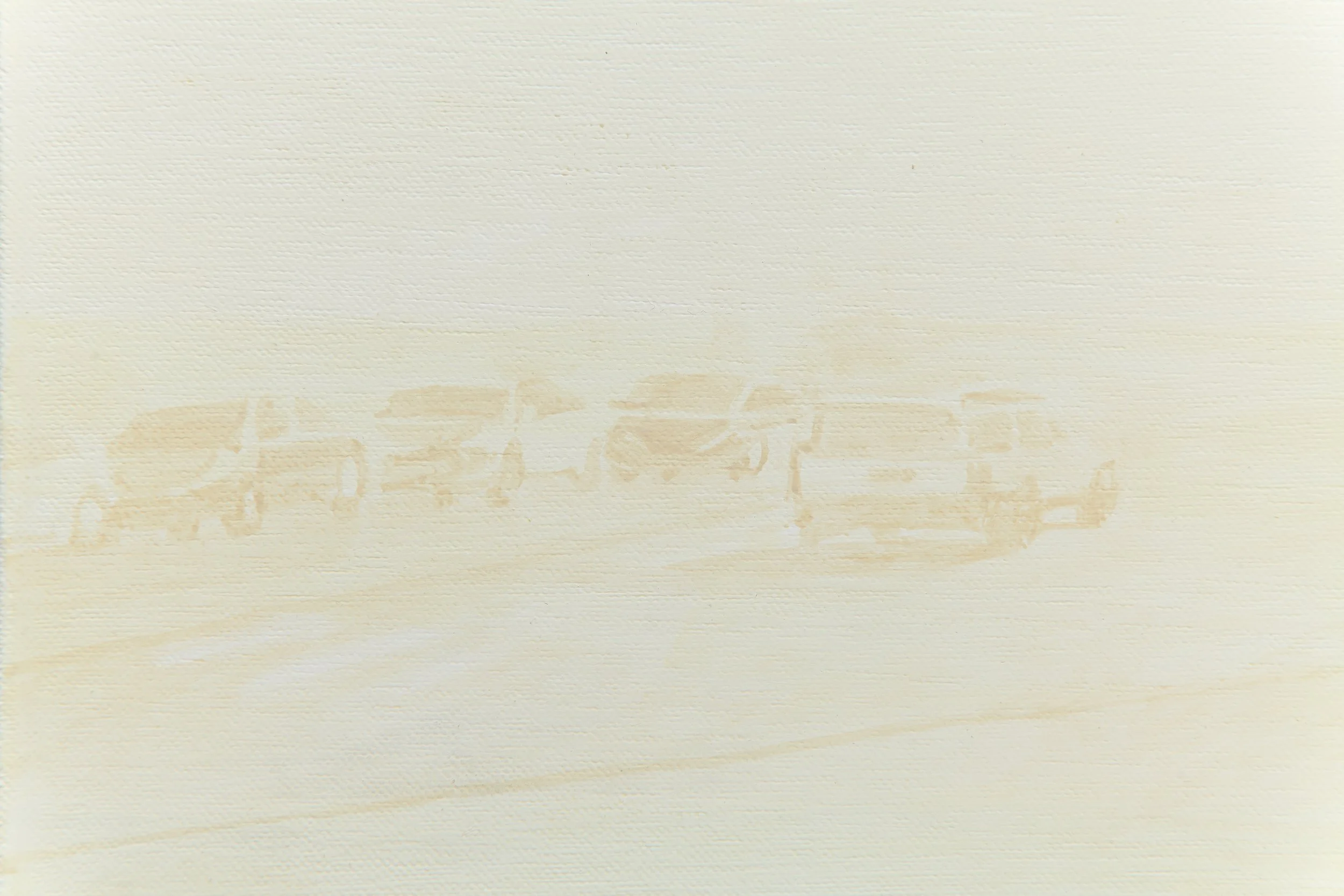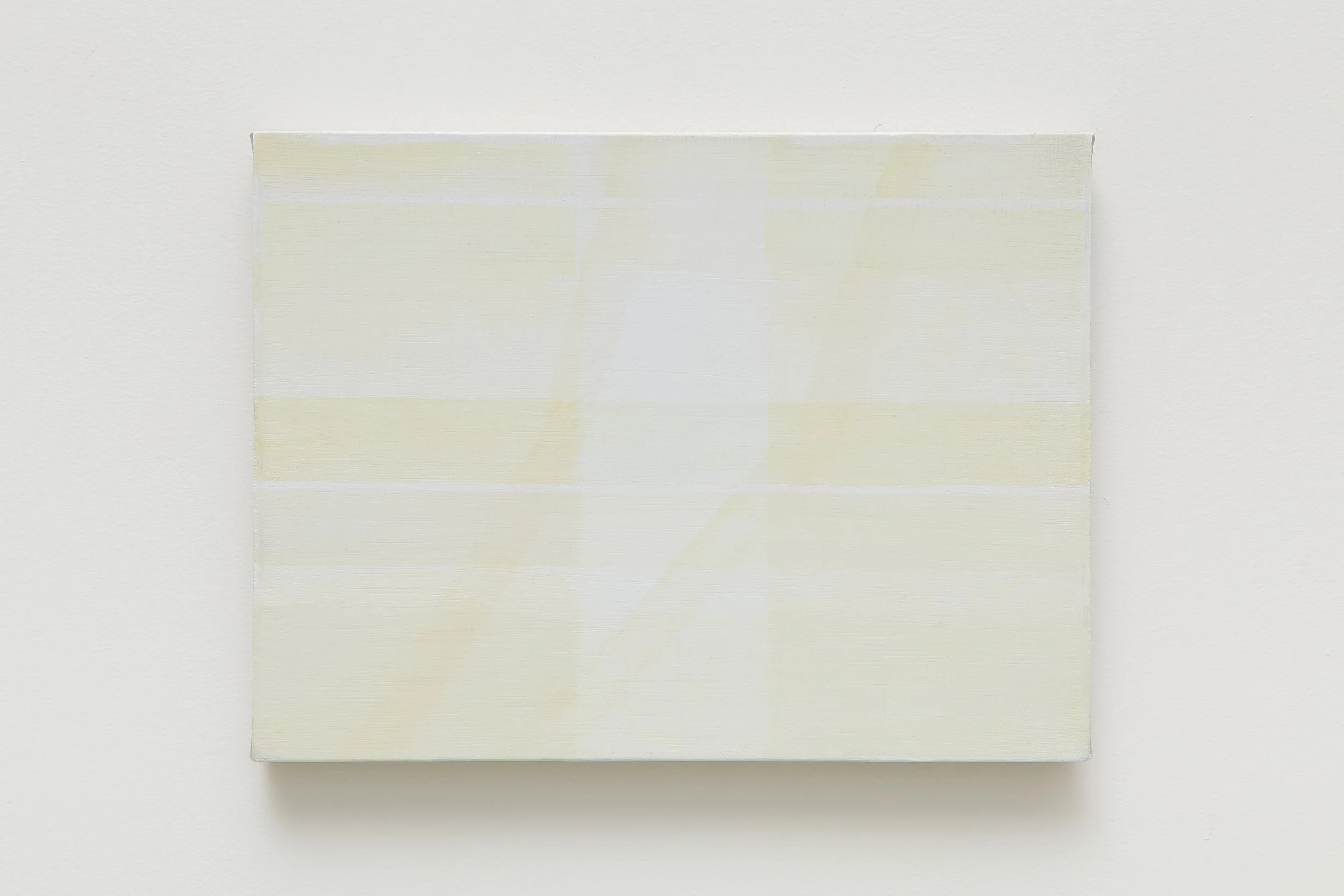SERVICE
GLORIA MAXIMO
October 19—November 24, 2025
JJ Cleaners & Laundromat | 339 East 5th St. New York, NY 10003
Desnivel is thrilled to present SERVICE, an exhibition by Gloria Maximo, taking place at JJ Cleaners & Laundromat in the East Village. This is part of our ongoing efforts to expand on the gallery model while recognizing the East Village as a historic neighborhood for artists and small business owners. Maximo is an inaugural recipient of the A.I.R. Commissioning Program for Mid-Career Women and Non-Binary Artists, and her exhibition MESO LEVEL opens October 18 at A.I.R. Gallery. Reframing the binary between productive and reproductive labor, Maximo images her own lived experiences of service industry and caregiving work, bringing a heightened attention to the economic value systems that we inherit and embody.
For the occasion, the artist has made a series of 9x12 grid paintings available at an accessible term of exchange set by the gallerist and the artist.
11:50 am
East 5th Street between 1st and 2nd, a quiet block, lined with early 20th century buildings, mostly brick, generally 5 stories, and a few storefronts. Pigeons perched out on fire escapes. Two doors sit open to the sidewalk, full service and self service. We walk in the second.
We find an empty washer (not OUT OF ORDER as some taped-on signs warn) and throw our clothes in, lucky washer #13, soap, select the cycle (Cold/Frio) and start the machine. Twenty quarters clink, disappearing. $5 and 30 minutes to go. We sit outside on plastic chairs to write this text, taking our place below the pigeons. Maybe they are waiting for something too. Inside the machine spins, colors swirl and blur. At this time on a Wednesday morning the laundromat is in a lull, besides the helpful owner who handed us $5 in quarters as our change, the price of operation.
11:54 am
Self service. These machines exist for us and others to use. Unseen to us is their daily, weekly, monthly, yearly maintenance. These machines do work for us, they allow us to sit. They give us time, while our clothes get clean.
11:56 am
We usually think of an action resulting in a product. The motion of one thing (the launderer) gives way to the motion of another (the laundry machine). But sometimes, the result is an absence—in this case, an absence of dirt or stains. We’re accustomed to thinking of work as additive, as making something, but just as often it is about removing. This is maybe a less glamorous kind of work; instead of having a finished product to show, you have something without, or even, a void. This kind of work can be a restoration, a setting right, a preparation to use again. Redemption even, in the parlance of recycling centers. This kind of work must be done over and over again. Repetition.
12:01 pm
Gloria Maximo’s paintings depict an economy of care, challenging our threshold of visibility as a way of drawing attention to the support networks all around us. They adjust our perception to the reality of need—the need for services, the need for employment, even the need for a place to be, how we position ourselves in a world which contains both desire and desperation. Her work induces us to cross this threshold and see things anew.
Here, her work will sit amongst many signs. OUT OF ORDER on machines, NO SMOKING posted at intervals around the room, HOURS OF OPERATION on the front window, NOT WORK on the change machine. These are meant to be read in a split second. Some customers may at first mistake Gloria’s work for a sign, newly added since their last wash visit, or effaced with the years. They may expect to read it in an instant, and discover that this sign withholds. It complicates the ecology, maybe even confuses.
12:06 pm
Everything here has a pale wash—the pale machines that line the room, the pale towels a woman is folding in the corner, even the color of the walls is pale. It’s as if any other shade would have stained this room of its cleanliness. Like it would throw everything into relief. Like we would see too much.
Yet it’s not clinical per se. There’s something foamy in it. It smells of chemical detergent. The air pulls it out onto the sidewalk through the open door. It smells of foam.
Foam is what happens before it’s clean. Foam bubbles and suds with a little agitation, in order to lift the dirt we can’t see. Foam foments. It is a moment of suspension, between the stillness and motion. This yellow is foamy. It seems to hold the things we can’t see, but suspect are there. To see it all would be against the point.
12:09 pm
Gloria’s work will co-exist with colors—the swirling colors of clothes washing and drying, the yellow of the countertops, the subtle shifting of off-white tones of the walls, the green of plants catching the light through the windows, brightly colored laundry bags piled up. These will all be reflected or absorbed by her paintings, which present surfaces that accommodate their atmospheres. As you sit with them, they unfold: the more you look the more you get. They reward the eyes of the bored, the waiting, the 11 minutes to go before we have to change to the dryer.
12:10 pm
Oh there’s Maria! She lives right next door, we run into her as she walks down the street with a friend. That’s the kind of interaction the laundromat allows for. The laundromat serves a community. People come and go, drop off, pick up, walk by and are reminded they are down to their last pair of socks.
It was barely noticeable to us at first, but everything on the block is architecturally integrated in a fabric of service and support. Once you need something—a bicycle rack, or a parking space, or laundry machine—it rises towards your awareness, towards your attention.
12:12 pm
Gloria’s work will live amongst sounds. Churning washers, clunking dryers, the whirr of changing cycles, the beep of finishing, the silence of the finished machines, the soft flop of folding, the clamor of coins, rolling carts, phone conversations, sidewalk shouting, passing vehicles. These paintings have heard similar soundscapes before, they don’t originate solely in a quiet hermetic studio, but in the lived experience of labor and service. They absorb that experience, which prepares them to open up to the eyes of those who understand that mode of work.
12:15 pm
The antidote to waiting (if indeed we need one) is to lose yourself in something. Most commonly now, that thing is a phone screen, but it need not be. We have become used to things that change before our eyes, but what about those things that our eyes themselves change? If we look at Gloria’s paintings, they require our eyes to both rest and work, paradoxically. The more they rest on a subject, the more they work, the eye is funny in that way.
12:17 pm
If you were to sweep, to use a broom to clean the floor, you would become more and more aware of the floor which otherwise is hidden by your selective filter of awareness. The floor might even become beautiful.
12:19 pm
One more minute, our wash load is almost done. The day outside has been sunny, our eyes have to adjust as we enter back into the laundromat. Again the eye at work.
—Darling Green, 2025


